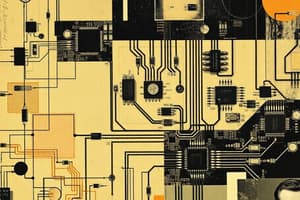Podcast
Questions and Answers
How can a digital enabled GPIO pin on NodeMCU/ESP8266 be configured when set as an input?
How can a digital enabled GPIO pin on NodeMCU/ESP8266 be configured when set as an input?
- Internal pull-up or pull-down (correct)
- High impedance only
- Edge-trigger or level-trigger
- Edge-trigger only
Which UART interface on NodeMCU/ESP8266 provides asynchronous communication at up to 4.5 Mbps?
Which UART interface on NodeMCU/ESP8266 provides asynchronous communication at up to 4.5 Mbps?
- RST0
- UART1
- UART0 (correct)
- TXD1
What is the main function of UART1 (TXD1 pin) on NodeMCU/ESP8266?
What is the main function of UART1 (TXD1 pin) on NodeMCU/ESP8266?
- Data transmit signal (correct)
- Data receive signal
- CTS signal
- RST signal
How many UART interfaces are available on NodeMCU/ESP8266 for communication purposes?
How many UART interfaces are available on NodeMCU/ESP8266 for communication purposes?
What is the maximum communication speed supported by UART0 on NodeMCU/ESP8266?
What is the maximum communication speed supported by UART0 on NodeMCU/ESP8266?
Which ADC precision is embedded in the NodeMCU for analog to digital conversion?
Which ADC precision is embedded in the NodeMCU for analog to digital conversion?
How many PWM pins are available on the NodeMCU?
How many PWM pins are available on the NodeMCU?
Which pin is used for SDIO on the NodeMCU?
Which pin is used for SDIO on the NodeMCU?
How many SPI pins are there on the NodeMCU?
How many SPI pins are there on the NodeMCU?
Which pin is used for UART RX on the NodeMCU?
Which pin is used for UART RX on the NodeMCU?
How many ADC channels are present in the NodeMCU?
How many ADC channels are present in the NodeMCU?
Which pin on the NodeMCU can be used for both SPI and I2C interfaces?
Which pin on the NodeMCU can be used for both SPI and I2C interfaces?
What is the supported frequency range for Pulse Width Modulation (PWM) on NodeMCU/ESP8266?
What is the supported frequency range for Pulse Width Modulation (PWM) on NodeMCU/ESP8266?
Which pins are used to reset the ESP8266 chip among the control pins on NodeMCU/ESP8266?
Which pins are used to reset the ESP8266 chip among the control pins on NodeMCU/ESP8266?
How many channels of Pulse Width Modulation (PWM) are available on NodeMCU/ESP8266?
How many channels of Pulse Width Modulation (PWM) are available on NodeMCU/ESP8266?
What is the maximum clock frequency supported by the SDIO interface on NodeMCU/ESP8266?
What is the maximum clock frequency supported by the SDIO interface on NodeMCU/ESP8266?
Which SPI feature allows for timing modes in the SPI format transfer?
Which SPI feature allows for timing modes in the SPI format transfer?
What is the purpose of the Chip Enable pin (EN) among the control pins on NodeMCU/ESP8266?
What is the purpose of the Chip Enable pin (EN) among the control pins on NodeMCU/ESP8266?
Flashcards are hidden until you start studying
Study Notes
NodeMCU/ESP8266 Features
- GPIO Pins: 17 pins can be assigned to functions such as I2C, I2S, UART, PWM, IR Remote Control, LED Light, and Button programmatically.
- GPIO configurability: internal pull-up or pull-down, high impedance, edge-trigger or level-trigger to generate CPU interrupts.
ADC Channel
- NodeMCU embedded with a 10-bit precision SAR ADC.
- Two functions can be implemented using ADC: testing power supply voltage of VDD3P3 pin and testing input voltage of TOUT pin.
UART Pins
- Two UART interfaces (UART0 and UART1) for asynchronous communication (RS232 and RS485).
- UART0: provides communication with TXD0, RXD0, RST0, and CTS0 pins.
- UART1: only data transmit signal, usually used for printing log.
SPI Pins
- NodeMCU/ESP8266 features two SPIs (SPI and HSPI) in slave and master modes.
- Supports 4 timing modes, up to 80 MHz, and divided clocks of 80 MHz, and up to 64-Byte FIFO.
SDIO Pins
- Secure Digital Input/Output Interface (SDIO) for directly interfacing SD cards.
- Supports 4-bit 25 MHz SDIO v1.1 and 4-bit 50 MHz SDIO v2.0.
PWM Pins
- 4 channels of Pulse Width Modulation (PWM) for driving digital motors and LEDs.
- PWM frequency range: 1000 μs to 10000 μs (100 Hz to 1 kHz).
Control Pins
- Chip Enable pin (EN): enables the ESP8266 chip when pulled HIGH, works at minimum power when pulled LOW.
- Reset pin (RST): resets the ESP8266 chip.
- Wake pin: wakes the chip from deep-sleep.
Power Pins
- VIN pin: can supply the NodeMCU/ESP8266 and its peripherals directly.
- Three 3.3V pins: output of the onboard voltage regulator, can be used to supply power to external components.
- GND pins: ground pins of NodeMCU/ESP8266.
I2C Pins
- Can connect I2C sensors and peripherals, both I2C Master and I2C Slave are supported.
- I2C interface functionality: can be realized programmatically, with a maximum clock frequency of 100 kHz.
Studying That Suits You
Use AI to generate personalized quizzes and flashcards to suit your learning preferences.



